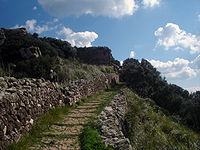
Castle of Santa Àgueda
Encyclopedia

Arabization
Arabization or Arabisation describes a growing cultural influence on a non-Arab area that gradually changes into one that speaks Arabic and/or incorporates Arab culture...
: Sent Agaiz) is found in the municipality of Ferreries
Ferreries
Ferreries is a municipality on the island of Minorca, in the Spanish autonomous community of the Balearic Islands. Its name is derived from the Catalan word ferrer , which in turn, comes from Latin word ferrum.- External links :* *...
, Minorca
Minorca
Min Orca or Menorca is one of the Balearic Islands located in the Mediterranean Sea belonging to Spain. It takes its name from being smaller than the nearby island of Majorca....
. It is situated over an elongated plateau
Plateau
In geology and earth science, a plateau , also called a high plain or tableland, is an area of highland, usually consisting of relatively flat terrain. A highly eroded plateau is called a dissected plateau...
, called Santa Àgueda, 264 m above sea level
Above mean sea level
The term above mean sea level refers to the elevation or altitude of any object, relative to the average sea level datum. AMSL is used extensively in radio by engineers to determine the coverage area a station will be able to reach...
. It is the third highest point in the island behind Monte Toro (358 m) and S'Esclusa (275 m). The castle is accessed by an ancient Roman road
Roman road
The Roman roads were a vital part of the development of the Roman state, from about 500 BC through the expansion during the Roman Republic and the Roman Empire. Roman roads enabled the Romans to move armies and trade goods and to communicate. The Roman road system spanned more than 400,000 km...
. Next to the castle there was also, until recently, a chapel dedicated to Saint Agatha.
History
The Castle of Santa Àgueda was built over an ancient RomanAncient Rome
Ancient Rome was a thriving civilization that grew on the Italian Peninsula as early as the 8th century BC. Located along the Mediterranean Sea and centered on the city of Rome, it expanded to one of the largest empires in the ancient world....
castra
Castra
The Latin word castra, with its singular castrum, was used by the ancient Romans to mean buildings or plots of land reserved to or constructed for use as a military defensive position. The word appears in both Oscan and Umbrian as well as in Latin. It may have descended from Indo-European to Italic...
by the Arab
Arab
Arab people, also known as Arabs , are a panethnicity primarily living in the Arab world, which is located in Western Asia and North Africa. They are identified as such on one or more of genealogical, linguistic, or cultural grounds, with tribal affiliations, and intra-tribal relationships playing...
s, when Manûrqa
Manûrqa
Manûrqa was the Arabicized name given to the island of Minorca by the Muslims from its annexation to the Caliphate of Cordoba by 'Isâm al-Khawlânî in 903 until the rule of the last Muslim ra'îs, Abû 'Umar ibn Sa'îd in 1287. The only urban centre of the island was Madînat al Jazîra or al Manûrqa...
(Minorca) was part of the Caliph of Cordoba. The exact date of its construction is not known, but it was prior to 1232.
In 1287, it became the last standpoint of resistance by the Arab inhabitants when the island was invaded by King Alfonso III of Aragon
Alfonso III of Aragon
Alfonso III , called the Liberal or the Free , was the King of Aragon and Count of Barcelona from 1285...
. The castle was later destroyed by Alfonso's grand-nephew King Peter IV of Aragon
Peter IV of Aragon
Peter IV, , called el Cerimoniós or el del punyalet , was the King of Aragon, King of Sardinia and Corsica , King of Valencia , and Count of Barcelona Peter IV, (Balaguer, September 5, 1319 – Barcelona, January 6, 1387), called el Cerimoniós ("the Ceremonious") or el del punyalet ("the one...
around 1343.
The Castle of Santa Àgueda (2006) is in ruins. There is a project by the local insular government, Plan Especial de Protección de Santa Àgueda (PEP) (2004), to rehabilitate and refurbish Santa Àgueda.
The Consell Insular de Menorca, Minorca's Island Council, announced on the 17 January 2007 the acquisition of the castle from its former private owners, this coincided with Minorca's National Day, the same day that the island was conquered by Alfons III of Aragon.

